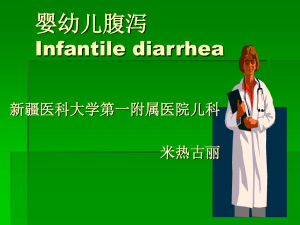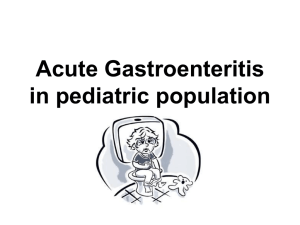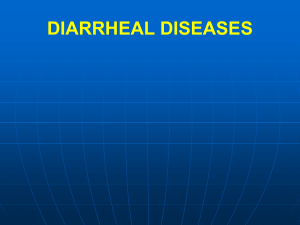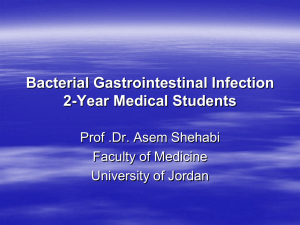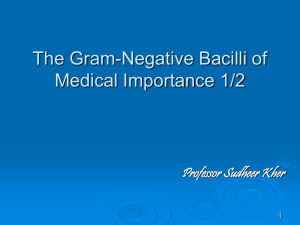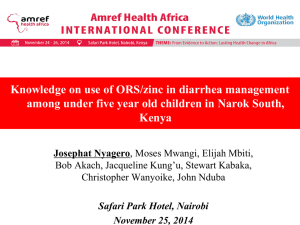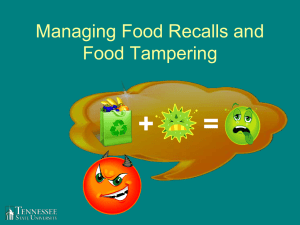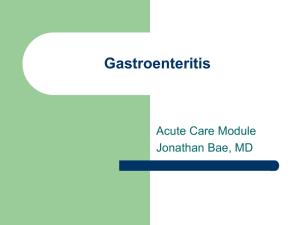Acute Diarrhea - Liaquat University of Medical & Health Sciences
advertisement
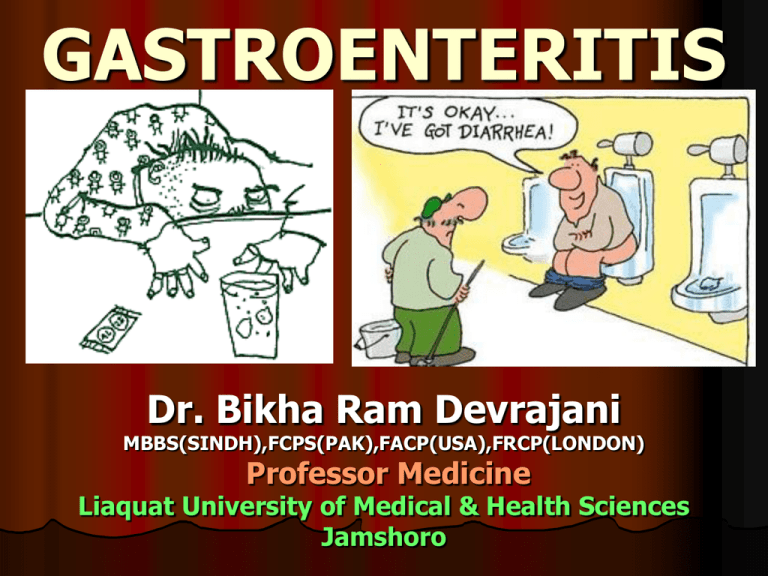
GASTROENTERITIS Dr. Bikha Ram Devrajani MBBS(SINDH),FCPS(PAK),FACP(USA),FRCP(LONDON) Professor Medicine Liaquat University of Medical & Health Sciences Jamshoro Gastroenteritis Gastroenteritis is a nonspecific term for a variety of pathologic states of the gastrointestinal tract. The primary manifestation is diarrhea, but it may be accompanied by nausea, vomiting, and abdominal pain. A universal definition of diarrhea does not exist, although patients seem to have no difficulty defining their own situation. Gastroenteritis Although most definitions center around the frequency, consistency, and water content of stools, the author prefers the definition that diarrheal stools take the shape of their container. Gastroenteritis Severity of illness may vary from mild and inconvenient to severe and life threatening. Appropriate management requires extensive history and assessment and appropriate general supportive and, often, etiology-specific treatment. Diarrhea associated with nausea and vomiting is referred to as gastroenteritis. Diarrhea is…….. A symptom characterized by an abnormal increase in stool frequency or liquidity Acute diarrhea is usually self limiting and lasts 48-72 hours, sometimes up to 7 days Chronic diarrhea lasts more than 4 weeks, should seek medical care Global Problem 4.6 million children less than 5 years of age die of diarrheal diseases. Diarrhea accounts for 19% of all deaths among children ages 0-4. Eighty-five percent of diarrheal deaths occur in the first year of life. World Health Organization. 1997. WHO Fact Sheet: Reducing Mortality from Major Childhood Killer Diseases. Fact Sheet Number 180. http://www.who.int/chd/pub/imci/fs_180.html Centers for Disease Control and Prevention. 1992. Diarrhea: The Management of Acute Diarrhea in Children: Oral Rehydratioin, Maintenance, and Nutritional Therapy. http://www.rehydrate.org/html Graph. http://www.who.int/chd/images/deaths.gif OUTBREAKS July 1998: E coli 0157:H7 infection outbreak from contaminated water supply in Wyoming, more than 60 infected July 1995: 77 cases of cryptosporidiosis at a day camp in Florida, most likely secondary to water hose contamination August-September 1999: E coli 0157:H7 infections secondary to contaminated well water in Washington County Fair (New York) OUTBREAKS Three to five billion cases of acute diarrhea occur yearly, and it is the leading cause of death in many underdeveloped countries. Approximately 30-50% of visitors to developing countries will develop, and perhaps return with, diarrhea. Age Gastroenteritis may occur at any age. Morbidity and mortality are much higher in the very young and the very old. Transmission • Diarrheal agents are mostly spread via the fecal-oral route. – physical contact with infected feces – eating or drinking contaminated food or water – person to person relay World Health Organization. 1998. The Epidemiology and Etiology of Diarrhea. http://www.who.int/chd/pub/cdd/meded/1med.html Socioeconomic factors • • • • • Poverty Overcrowding Poor sanitation Contamination of water Inadequate food hygiene UNICEF. 1998. The State of the World’s Children, 1998. Oxford and New York: Oxford University Press. Diarrheal illnesses also may be classified • Osmotic, due to an increase in the osmotic load presented to the intestinal lumen, either through excessive intake or diminished absorption • Inflammatory (or mucosal), when the mucosal lining of the intestine is inflamed. • Secretory, when increased secretory activity occurs • Motile, caused by intestinal motility disorders Etiological Agents • Bacterial, Viral, and • Protozoans Parasitic Agents • Giardia • Rotavirus Rotavirus • Enterotoxigenic E. Coli • Shigellae • Salmonellae • Vibrio Cholerae • Campylobacter jejuni • Cryptosporidium Giardia E.Coli • Entamoeba World Health Organization. 1997. http://www.who.int/chd/pub/imci/fs_180.html Etiology of diarrhea • Diarrhea is a symptom of an underlying • • • • • • pathology or infection Viral gastroenteritis Bacterial gastroenteritis Protozoal diarrhea Antibiotic associated diarrhea AIDS associated diarrhea Food-induced diarrhea Etiology of diarrhea • Viral (50-70%) – The Norwalk virus is the leading cause of viral gastroenteritis in the United States. Norwalk virus belongs to the species of Noroviruses (formerly known as Norwalk-like viruses). Noroviruses, along with the Sapoviruses (formerly known as Sapporo-like viruses) are members of the Caliciviridae family of viruses. – Caliciviruses: Various caliciviruses, other than Norwalk, are likely responsible for many out breaks of previously unidentified viral gastroenteritis. – Rotavirus: A leading cause of gastroenteritis in children, but can also be found in adults. May cause severe dehydration. – – – – – – Adenovirus Parvovirus Astrovirus Coronavirus Pestivirus Torovirus Etiology of diarrhea • Bacterial (15-20%) – Shigella – Salmonella – C jejuni – Yersinia enterocolitica – E coli - Enterohemorrhagic 0157:H7, enterotoxigenic, enteroadherent, enteroinvasive – V cholera – – – – – – – – – Aeromonas B cereus C difficile Clostridium perfringens Listeria Mycobacterium avium-intracellulare (MAI), immunocompromised Providencia Vibrio parahaemolyticus Vibrio vulnificus Etiology of diarrhea • Parasitic (10-15%) – Giardia – Amebiasis – Cryptosporidium – Cyclospora • Food-borne toxigenic diarrhea – Preformed toxin - S aureus, B cereus – Postcolonization - V cholera, C perfringens, enterotoxigenic E coli, Aeromonas Etiology of diarrhea • Shellfish poisoning and poisoning from other marine animals – Paralytic shellfish poisoning (PSP) - Saxitoxin – Neurologic shellfish poisoning (NSP) - Brevotoxin – Diarrheal shellfish poisoning (DSP) - Okadaic acid – Amnesic shellfish poisoning - Domoic acid – Ciguatera (ciguatoxins) – Scombroid (conversion of histidine to histamine) Etiology of diarrhea • Drug-associated diarrhea – – – – – – Antibiotics due to alteration of normal flora Laxatives, including magnesium-containing antacids Colchicine Quinidine Cholinergics Sorbitol • Pseudomembranous colitis – Overgrowth of C difficile – Positive C difficile assay Etiology of diarrhea • Other causes – – – – – Unknown agents, especially in developing countries Ischemic colitis Ulcerative colitis Crohn disease Carcinoid tumor or vasoactive intestinal peptide tumor (VIPoma) – AIDS – Dumping or short bowel syndrome – Radiation or chemotherapy Viral gastroenteritis • 80-85% of episodes of acute diarrhea are caused by viruses • Virus transmitted by contaminated food or water • Clinical features include 12-48hr incubation period followed by vomiting, watery diarrhea and low grade fever • Illness lasts 5-8 days, treatment is fluid and electrolyte therapy Bacterial gastroenteritis • Common pathogens are Campylobacter, Salmonella, Shigella, E.coli, Staphylococcus, Clostridium • If attack is in small intestine patients usually • experience abrupt onset of large volume, watery stools, upper abdominal pain, nausea, vomiting, cramps, and low grade fever If attack is in large intestine, patients may experience dysentery like syndrome including bloody or mucousy diarrhea Traveler’s diarrhea • A form of bacterial gastroenteritis • Usually occurs when people travel to warmer climates with poor sanitation • Most commonly caused by E.coli • Characterized by sudden onset of loose stools, nausea, occasional vomiting, cramps, bloating, malaise and low grade fever • Usually subsides over 3-4 days Protozoal diarrhea • Giardia lamblia and entamoeba histolytica are protozoa associated with diarrhea • Usually acquired traveling to mountainous or recreational water areas, drinking stream or pond water • No nonprescription therapy for protozoal diarrhea, metronidazole is treatment of choice Antibiotic associated diarrhea • Frequency of diarrhea is largely dependent on • • the extent to which the drug disrupts the normal intestinal flora Abx that have broad spectrum activity against aerobes and anaerobes can produce diarrhea AAD may be caused by an overgrowth of abx resistant bacteria, fungi, or toxin producing C.difficile • Diarrhea caused by C.difficile is usually watery • and greenish-mucoid There are no nonprescription treatments for eradicating C.difficile AIDS Associated Diarrhea • Patients with AIDS or HIV are known to be susceptible to intestinal infections that produce diarrhea • These patients should not self-manage their diarrhea, they should see their physician Food-Induced Diarrhea • Food intolerance can provoke diarrhea • The enzyme lactase hydrolyzes disaccharides into monosaccharides • When you lack the lactase enzyme, disaccharides can not be hydolyzed to monosaccharides • Disaccharides pool in lumen causing an osmotic imbalance which draws fluid into the lumen and causes diarrhea Signs of Dehydration • Common: dizziness, thirst, confusion, lethargy, • • • • • fatigue Serious: low BP, fever, vomiting, abdominal cramps, nausea, muscle aches, mucously stools, weight-loss Mild dehydration: 3-5% weight-loss Severe dehydration: 10% weight-loss (can be very serious in infants, may lead to cardiovascular collapse and renal failure Mild/moderate diarrhea are self-treatable Severe diarrhea: non self-treatable Laboratory Investigations Stool DR, ova & cyst, and C/S. CBC. Serum electrolytes. Blood urea. Other investigations depend upon the causative agent. Treatment Options Treatment Outcomes 1. Assess and Correct electrolyte and fluid loss 2. Manage diet or disease 3. Provide relief 4. Identify cause Oral Rehydration Therapy Fluid and Electrolyte Replacement Not more than 75-90 mEq/L of Na for rehydration Not more than 40-60 mEq of Na for maintenance Carb to Na ratio should be 2:1 Important in children and infants All patients should rehydrate and maintain during diarrheal episode Loperamide Good for treatment of traveler’s diarrhea and IBD Works by slowing intestinal motility Use 4mg initially, then 2mg after each loose stool but do not exceed 16mg/day (8 tablets) Do not use in children <6 years old use electrolyte tx instead Absorbents Include attapulgite, kaolin, pectin Do not recommend because of decreased absorption of other drugs Things to Remember Always remember to rehydrate Special populations (elderly, <3 years old, pregnant) require medical referral Healthy patients usually improve within 24 to 48 hours If condition remains or worsens after 48 hours - refer to MD Complications of Diarrhea Acute diarrhea may cause severe dehydration and electrolyte imbalance Infants, young children, and the elderly are most at risk for dehydration Children less than 2 yrs of age often have complications that require hospitalization First steps for managing an outbreak of acute diarrhoea THIS PRESENTATION AIMS AT GUIDING YOU THROUGH THE VERY FIRST DAYS OF AN OUTBREAK WORLD HEALTH ORGANIZATION Is this the beginning of an outbreak? WORLD HEALTH ORGANIZATION You might be facing an outbreak very soon if You have seen an unusual number of acute diarrhoeal cases this week and the patients have the following points in common: – they have similar clinical symptoms (watery or bloody diarrhoea) – they are living in the same area or location – they have eaten the same food (at a burial ceremony for example) – they are sharing the same water source – there is an outbreak in the neighbouring community WORLD HEALTH ORGANIZATION or You have seen an adult suffering from acute watery diarrhoea with severe dehydration and vomiting If you have some statistical information from previous years or weeks verify if the actual increase of cases is unusual over the same period of time. WHAT DO I HAVE TO DO WHEN I SUSPECT AN OUTBREAK? 1. Inform and ask for help 2. Protect the community 3. Treat the patients diarrhea MESSAGE TO THE COMMUNITY MESSAGE TO THE COMMUNITY MESSAGE TO THE COMMUNITY MESSAGE TO THE COMMUNITY PROTECT YOURSELF FROM CONTAMINATION Wash your hands with soap before and after taking care of the patient Cut your nails 3. TREAT THE PATIENTS 80% of the cases can be treated with Oral Rehydration Salt (ORS) Mortality/Morbidity Estimates for mortality and morbidity vary widely. In the United States, 210,000 pediatric hospitalizations occur yearly with as many as 10,000 deaths. Internationally, mortality rate is 5-10 million deaths each year. Thank you
